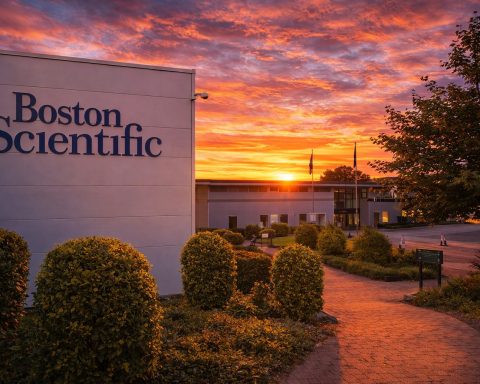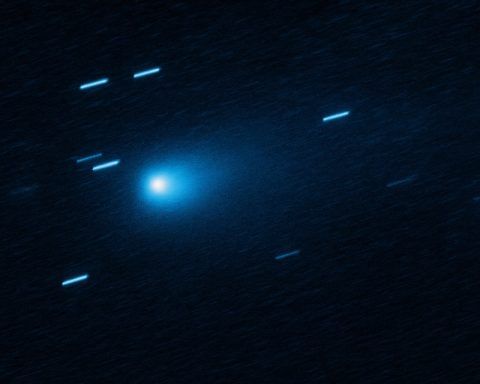- NASA’s James Webb Space Telescope identified over 300 unusually bright objects in infrared images that may be among the universe’s earliest galaxies.
- One of these objects has been spectroscopically confirmed as an early galaxy.
- Researchers used a dropout technique to identify high-redshift galaxy candidates from the dawn of the universe.
- If confirmed, these objects could force a rewrite of galaxy formation models by showing massive, bright galaxies formed earlier than current theory predicts.
- NASA’s Parker Solar Probe flew through the Sun’s outer atmosphere, directly observing magnetic reconnection that snaps and reconnects magnetic field lines, solving a 70-year mystery.
- The mission data validated decades-old magnetic reconnection models and will improve space-weather forecasts to protect satellites and power grids on Earth.
- An Oxford-led team engineered yeast to produce six pollen sterols, creating a sterol-rich supplement for honeybees.
- In greenhouse trials, colonies fed this sterol-rich diet reared up to 15× more larvae than controls and continued breeding for the full 3-month trial, while nutrient-deficient colonies stopped after 90 days.
- Researchers identified an ISG15 gene deficiency that confers near-viral immunity, and developed an experimental nasal-delivered mRNA therapy that triggers ten antiviral proteins and blocked flu and COVID-19 in mice and hamsters.
- A Rice University study directly observed flat electronic bands in the kagome superconductor CsCr3Sb5, showing these flat bands govern its superconductivity and magnetism under pressure.
Webb Telescope Spots Ancient Galaxies That Defy Cosmic Theories (Astronomy)
Astronomers using NASA’s James Webb Space Telescope (JWST) have identified over 300 unusually bright objects that may be some of the universe’s earliest galaxies [1]. These candidate galaxies, observed by a University of Missouri team in JWST’s infrared images, shine far brighter than expected for their age. “If even a few of these objects turn out to be what we think they are, our discovery could challenge current ideas about how galaxies formed in the early universe,” said Dr. Haojing Yan, astronomy professor at Mizzou and co-author of the study [2]. The researchers used a “dropout” technique to pick out high-redshift objects likely from the dawn of the universe. Spectroscopic confirmation is underway, with one object already verified as an early galaxy [3].
Why it matters: If confirmed, these primordial galaxies would force a rewrite of galaxy formation models, showing that massive, bright galaxies emerged much earlier than theory predicts [4] [5]. This could deepen our understanding of the universe’s first stars and structures in the post-Big Bang era.
Parker Solar Probe Proves 70-Year-Old Sun Theory True (Space Physics)
For the first time, a spacecraft has flown through the Sun’s explosive atmosphere and directly observed how the Sun’s magnetic fields snap and reconnect – solving a 70-year mystery in solar physics [6]. NASA’s Parker Solar Probe swooped through a region of the Sun where powerful magnetic reconnection occurs, “confirming a theory that scientists have debated for 70 years,” according to a Southwest Research Institute team leading the mission [7]. This process unleashes tremendous energy driving solar flares and coronal mass ejections. Dr. Ritesh Patel (SwRI solar scientist and lead author) noted that Parker’s data validated decades-old magnetic reconnection models and finally filled in the missing pieces between near-Earth observations and the Sun’s behavior [8] [9].
Why it matters: The breakthrough explains how solar storms erupt and is “key to predicting these disruptive solar storms before they reach our planet” [10]. Better understanding the Sun’s outbursts will improve space-weather forecasts and help protect satellites, power grids, and communications on Earth from geomagnetic blasts [11] [12].
Engineered “Superfood” Boosts Honeybee Colonies 15-Fold (Biology)
In a win for pollinators, scientists have developed a breakthrough nutritional supplement for honeybees that dramatically improves colony health [13]. A University of Oxford-led team engineered yeast to produce six key sterols (nutrients found in flower pollen) that are missing from standard bee feeds [14] [15]. In greenhouse trials, bee colonies fed this sterol-rich “superfood” reared up to 15× more larvae than those on ordinary diets [16]. “Our study demonstrates how we can harness synthetic biology to solve real-world ecological challenges,” said Prof. Geraldine Wright (Oxford biologist), noting that these vital pollen sterols can’t be harvested at scale in nature [17]. Lead author Dr. Elynor Moore added that for bees, the improved diet is like humans finally eating fully balanced meals instead of ones missing essential nutrients [18].
- Key findings: Colonies on the enriched yeast diet raised 15 times more bee larvae to the pupal stage than control colonies [19]. They also continued breeding for the full 3-month trial, whereas nutrient-deficient colonies stopped after 90 days [20].
Why it matters:Honeybees pollinate ~70% of leading global crops, but have suffered devastating declines (40–50% colony losses annually, reaching 60–70% in 2025) [21]. This nutrient solution could be a “game changer” for agriculture, boosting bee reproduction and resilience without straining natural pollen sources [22] [23]. Stronger bee colonies help secure our food supply and biodiversity in the face of climate change and other stressors.
Melting Glaciers Linked to Volcanic Eruptions and Quakes (Climate Science)
As climate change thaws Earth’s ice, scientists warn of a less obvious threat: unleashed volcanoes and earthquakes. New research in the Andes found that when glaciers rapidly melted at the end of the last ice age, the pressure release on Earth’s crust triggered volcanic eruptions by “popping the lid” off magma chambers [24]. Today, Iceland serves as a natural lab where geologists are monitoring quakes and magma beneath retreating glaciers. “When you take the load off, it’s just like opening a Coke bottle,” explains Dr. Brad Singer, a University of Wisconsin–Madison geoscientist, illustrating how diminishing ice can let pent-up magma explode [25]. More than 100 volcanoes lurk under Antarctica’s ice sheet, which could be destabilized from below as the ice melts [26]. Rising sea levels themselves add weight that might provoke seismic activity in coastal faults [27].
Why it matters: Glacial melt is not just a symptom of climate change – it can fuel a dangerous feedback loop. Removing ice “lids” can trigger eruptions that spew heat-trapping ash and gases, accelerating global warming and sea-level rise on a faster timeline [28]. In Antarctica, such volcanic activity could hasten ice sheet collapse. This emerging research underscores that climate and geology are intertwined, meaning today’s warming could spark natural disasters in unexpected ways.
Rare Gene Mutation Inspires Universal Antiviral Therapy (Medicine)
Researchers have discovered a rare genetic mutation that makes a handful of people virtually immune to all viruses – and turned this finding into a prototype broad-spectrum antiviral treatment. Immunologist Dr. Dusan Bogunovic at Columbia University noticed that patients with an ISG15 gene deficiency (a rare immune disorder) never fell seriously ill from viruses [29] [30]. Their bodies have mild persistent inflammation that happens to block viral replication. Now his team has developed an experimental mRNA therapy that safely replicates this effect. In recent animal trials, a nasal-delivered cocktail of mRNAs induced cells to produce a set of ten defensive proteins, preventing flu and COVID-19 viruses from multiplying and causing illness in mice and hamsters [31]. “We have yet to find a virus that can break through the therapy’s defenses,” Bogunovic says of the approach [32]. Crucially, the induced antiviral state lasts only a few days – enough to fend off infection without the harmful chronic inflammation seen in ISG15-deficient people [33].
Why it matters: This could be a game-changing strategy for pandemic defense. The Columbia team envisions the treatment as a universal antiviral shield for first responders and high-risk people when a new outbreak strikes [34]. “We believe the technology will work even if we don’t know the identity of the virus,” Bogunovic notes, highlighting its plug-and-play potential against future threats [35]. In short, a temporary dose could protect anyone from any virus – a bold step toward next-gen pandemic preparedness [36] [37].
Quantum “Flat Band” Phenomenon Confirmed in Superconductor (Physics)
In a milestone for quantum physics, scientists have directly observed a strange electronic behavior in a special material called a kagome superconductor – confirming a theoretical prediction for the first time. A Rice University-led team found experimental proof that “flat bands” of electrons exist and actively dictate the material’s properties [38]. Flat electronic bands were long theorized to enable exotic states of matter, but evidence of them influencing real materials was elusive until now. By using advanced X-ray and photoemission techniques, the researchers showed that in a pressurized kagome metal (CsCr₃Sb₅), these flat bands are not idle – they shape the superconductivity and magnetism of the system [39] [40]. “Our results confirm a surprising theoretical prediction and establish a pathway for engineering exotic superconductivity through chemical and structural control,” said Prof. Pengcheng Dai of Rice, the study’s senior author [41]. Fellow physicist Prof. Ming Yi noted that identifying active flat bands shows a direct link between the lattice’s geometry and emerging quantum states [42].
Why it matters: This is a significant leap in quantum materials research. By proving flat-band physics is real and tunable, scientists can now deliberately design materials to exploit these effects [43] [44]. That could lead to new types of superconductors, quantum computers, or electronics that leverage unconventional quantum states. In essence, the finding provides a new toolset for creating next-generation electronic and spintronic technologies rooted in fundamental physics [45].
Breakthrough Catalyst Promises Affordable Green Hydrogen (Chemistry)
Chemists have discovered a low-cost catalyst that outperforms platinum-grade iridium for producing clean hydrogen fuel – a development that could slash the cost of green hydrogen energy. Led by Prof. Chad A. Mirkin at Northwestern University, researchers used a novel high-throughput method (a “nanoparticle megalibrary”) to rapidly test millions of metal combinations [46] [47]. In just hours, they pinpointed a winning mix of four abundant metals (a ruthenium-cobalt-manganese-chromium oxide) that can replace iridium in electrolyzers for water-splitting [48] [49]. The new catalyst proved slightly more active than pure iridium and highly stable, yet costs only a fraction of the price [50] [51]. “We’ve unleashed arguably the world’s most powerful synthesis tool… to find a material as good as iridium but more plentiful, available and a lot cheaper,” said Prof. Mirkin, the tool’s inventor [52]. Co-leader Prof. Ted Sargent highlighted that “there’s not enough iridium in the world to meet” the growing demand for hydrogen production [53] – hence the urgent need for alternatives.
Why it matters:Green hydrogen is pivotal for a zero-carbon energy future, from clean fuel cells to storing renewable power. But the reliance on scarce iridium (costing ~$5,000/ounce) in current hydrogen tech is a major bottleneck [54]. This discovery offers a viable path to scale up hydrogen production cheaply and sustainably, breaking our dependence on rare materials [55] [56]. Beyond hydrogen, the success of the nanoparticle megalibrary approach hints at a revolution in materials science – where AI and massive combinatorial screens could rapidly find optimal materials for batteries, catalysts, and more [57] [58].
AI-Designed Proteins Rejuvenate Cells, Marking Biotech Milestone (Computer Science/AI)
A stunning collaboration between OpenAI and Retro Biosciences has demonstrated that artificial intelligence can invent new proteins that make aged cells young again. Using a specialized GPT-4b “micro” model, researchers re-engineered the famous Yamanaka factors – proteins that induce cells to revert to a youthful stem-cell state. The AI-designed variants of these proteins achieved over 50× higher expression of stem cell markers and markedly improved DNA repair in lab tests, compared to the natural versions [59]. In fact, the AI-optimized cocktail drove cells to full pluripotency (a regenerative state) far more efficiently than standard methods [60]. OpenAI calls this result “proof that AI can meaningfully accelerate life science innovation,” after the protein designs were validated across multiple cell types and showed rejuvenation potential [61]. The breakthrough, detailed on August 22, underscores AI’s growing role in biotechnology.
Why it matters: This is one of the clearest examples yet of AI’s power in drug and therapy development. By massively searching the protein “design space,” the AI found tweaks that researchers hadn’t in decades of trial-and-error [62]. The enhanced Yamanaka proteins could speed up research into age reversal, tissue regeneration, and disease treatment. More broadly, it signals that AI may revolutionize bioengineering, delivering cures and enhancements (like anti-aging therapies) much faster than traditional R&D. As one report noted, the work is a milestone showing that AI-designed biomolecules can outperform natural ones, opening the door to longer and healthier lives [63].
Sources: The information in this report is drawn from recent scientific publications, official press releases, and reputable news outlets dated August 23–24, 2025 (with additional context from the surrounding week). Each discovery is linked to its primary source for further reading. All expert quotes and data points are documented from those sources, ensuring accuracy and credibility in this weekend science roundup.
References
1. scitechdaily.com, 2. scitechdaily.com, 3. scitechdaily.com, 4. scitechdaily.com, 5. scitechdaily.com, 6. scitechdaily.com, 7. scitechdaily.com, 8. scitechdaily.com, 9. scitechdaily.com, 10. scitechdaily.com, 11. scitechdaily.com, 12. scitechdaily.com, 13. www.sciencedaily.com, 14. www.sciencedaily.com, 15. www.sciencedaily.com, 16. www.sciencedaily.com, 17. www.sciencedaily.com, 18. www.sciencedaily.com, 19. www.sciencedaily.com, 20. www.sciencedaily.com, 21. www.sciencedaily.com, 22. www.sciencedaily.com, 23. www.sciencedaily.com, 24. www.ehn.org, 25. www.ehn.org, 26. www.ehn.org, 27. www.ehn.org, 28. www.ehn.org, 29. scitechdaily.com, 30. scitechdaily.com, 31. scitechdaily.com, 32. scitechdaily.com, 33. scitechdaily.com, 34. scitechdaily.com, 35. scitechdaily.com, 36. scitechdaily.com, 37. scitechdaily.com, 38. scitechdaily.com, 39. scitechdaily.com, 40. scitechdaily.com, 41. scitechdaily.com, 42. scitechdaily.com, 43. scitechdaily.com, 44. scitechdaily.com, 45. scitechdaily.com, 46. scitechdaily.com, 47. scitechdaily.com, 48. scitechdaily.com, 49. scitechdaily.com, 50. scitechdaily.com, 51. scitechdaily.com, 52. scitechdaily.com, 53. scitechdaily.com, 54. scitechdaily.com, 55. scitechdaily.com, 56. scitechdaily.com, 57. scitechdaily.com, 58. scitechdaily.com, 59. ts2.tech, 60. ts2.tech, 61. ts2.tech, 62. ts2.tech, 63. ts2.tech










